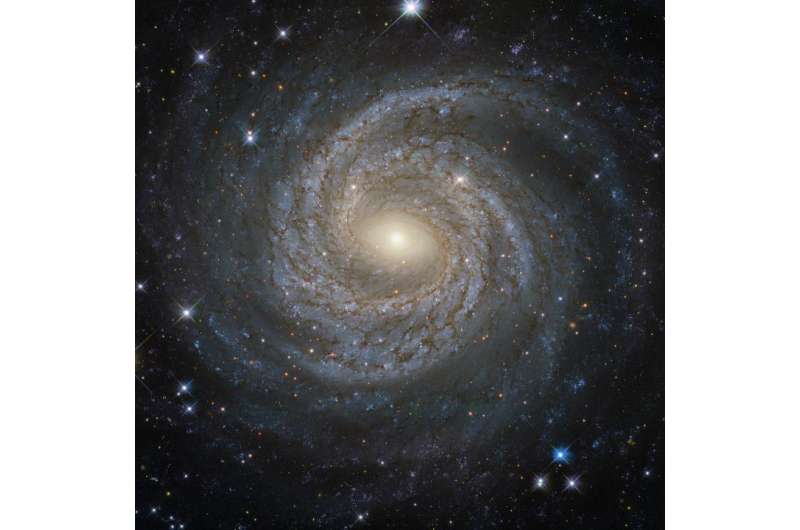December 22, 2016 report
Best of Last Year—The top Phys.org articles of 2016

(Phys.org)—It has been another great year for physics as a team at the University of California, Irvine confirmed the possible discovery of a fifth force of nature—an unknown subatomic particle that, if proven to exist, could change how scientists view their understanding of the universe.
Also making headlines was work done by a team with members from Trinity College Dublin's School of Physics and the CRANN Institute, Trinity College—they discovered a new form of light which, if future tests confirm its existence, could change how physicists view the fundamental nature of light itself. And a team with members from the University of California, Santa Barbara and Microsoft Station Q found evidence that suggested time crystals might exist after all.
Also, Verlinde's new theory of gravity passed the first test in experiments conducted by Leiden University astronomer Margot Brouwer through measuring the distribution of gravity around more than 33,000 galaxies. And Erik Verlinde with the University of Amsterdam and the Delta Institute for Theoretical Physics published a new theory of gravity that might explain dark matter and its curious impact on the motion of stars. Also, a pair of physicists—Julian Gonzalez-Ayala and F. Angulo-Brown—asked why is space three-dimensional? They report evidence that the second law of thermodynamics may help explain it. And a team of researchers at Leiden Institute of Physics confirmed a second layer of information in DNA—its mechanics, they believe, are also involved in determining who we are.
It was big year for space news as well, as a team working with the European Space Agency's Rosetta orbiter project confirmed that water ice was found on the surface of comet 67P—solving a longstanding mystery. Meanwhile, another team working with NASA's New Horizons project published imagery that revealed a small, frozen lake on Pluto. And a team at Wageningen University in the Netherlands announced that Dutch produce grown on 'Mars' soil was found safe to eat—four types of vegetables were grown in the soil that did not pull up heavy metals, offering the potential of feeding future astronauts. Also, data from the Atacama Large Millimeter/submillimeter Array, revealed that the black hole at the center of a galaxy named NGC 1068 was actually the source of its own exhaust. And Viking experimenters Gilbert Levin and Patricia Straat asked whether the 40-year-old Viking experiment discovered life on Mars. They believe the first Mars landers might have done just that, and published a perspective piece in the journal Astrobiology offering evidence.
It was good year for technology, as a team of IBM scientists achieved a storage memory breakthrough—by reliably storing three bits of data per cell using relatively new phase-change memory technology. Also, a team with the University of Illinois announced a breakthrough with solar cells that captured carbon dioxide and sunlight and produced burnable fuel. The cells are photosynthetic, not photovoltaic. And a team at the University of Maryland described how the newly discovered blue whirl fire tornado burns cleaner for reduced emissions—possibly leading to improvements in fuel efficiency. A team at the University of Southern California found that carbon dioxide captured from the air could be directly converted into methanol fuel, allowing for its possible use as an alternative fuel source.
In other news, a team of Australian and French researchers discovered why too much evidence can be a bad thing—because of something they call a "paradox of unanimity." Also, a team at Binghamton University found that they could identify individuals by observing their brain waves with 100 percent accuracy—they measured how the brain reacts to certain stimuli. And a trio of researches at Technion-Israel Institute of Technology in Israel announced that they had achieved perfect efficiency for a water-splitting half-reaction—shattering the previous record of 60 percent.
Also, a pair of researchers, Sara Graça da Silva and Jamshid Tehrani, conducted a phylogenetic analysis that suggested fairy tales are much older than thought—one may have even originated during the Bronze Age. And a small team of researchers dove into the mathematics of coffee extraction as part of searching for the ideal brew and developed a model they think might help. And finally, Robert Criss with Washington University claimed that the record Missouri flooding was a man-made calamity—the surprise 2015 flood was helped along, he suggested, by over-channeling.
Journal information: Astrobiology
© 2016 Phys.org





















